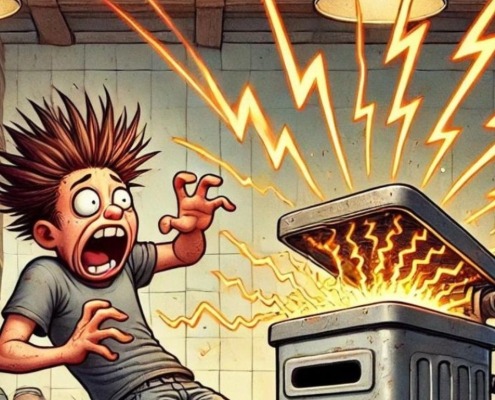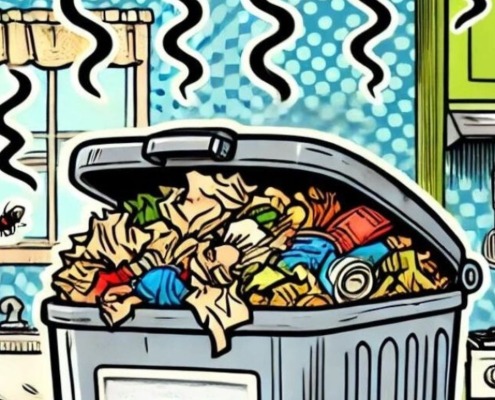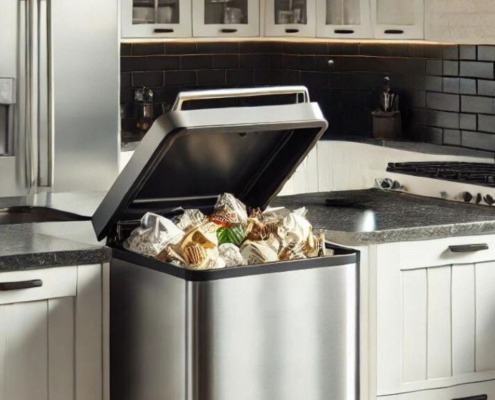How to fix a stuck trash compactor ram
Samantha Bullington / Tuesday February 27, 2024
Is your trash compactor ram stuck, turning waste reduction into frustration? Don’t worry—help is here to get your appliance back on track! Discover easy-to-follow troubleshooting steps and a how-to video just below, designed to help you fix this common household issue all by yourself.
If you like using a trash compactor to reduce the volume of your household waste, then you know that issues with the ram can be a real headache. The compacting ram is the part that packs the waste into the container so it becomes easier to manage and dispose of. A stuck ram can be frustrating, but you can repair this issue yourself.
If you need any replacement parts for your trash compactor, you can enter your model number at AppliancePartsPros.com to order them. Most orders arrive in just two business days, and we have thousands of free guides to show you how to install your new parts.
Whether you own a Whirlpool, KitchenAid, GE, JennAir, or any other brand of trash compactor, check out these troubleshooting steps to repair your stuck compacting ram.
WATCH: How to troubleshoot a trash compactor ram getting stuck
Keep safety first
Trash compactors are powerful appliances that exert up to 5,000 pounds of force during the compaction cycle. It’s important to follow these safety tips when troubleshooting and repairing a stuck trash compactor ram:
- Always power off and unplug your appliance or switch off the circuit breaker before you attempt any maintenance or replacement work. This keeps you safe by preventing any risk of electric shock.
- If the appliance has recently been used, give it plenty of time to cool down before working on it.
- Never place hazardous items such as glass, aerosol cans, batteries, or hard objects that don’t compress into the trash compactor, as they could damage the unit or cause injuries.
- Never use your hands or feet to compact the trash, as this could result in serious injuries. Always use the appropriate tools and follow proper safety procedures.
- If any safety features – such as the door switch or tilt switch – fail, it’s important to fix them quickly to prevent any damage or accidents.
- Take your time while working to prevent accidents and personal injuries. Rushing is the enemy of precision.
- Work in a well-lit area so you can clearly see and access appliance parts.
- Keep your workspace free of clutter and other obstacles. Keep children and pets away from the work area.
- Never work on internal parts with wet hands. Make sure the work area is completely dry.
- Check the user manual to see if there are specific installation or safety instructions related to your appliance or replacement part.
- Be gentle when handling or removing parts. Excessive force might damage the appliance or cause personal injury.
- Wear insulated work gloves to protect your hands from sharp metal parts and debris.
- When working with wires, avoid touching any exposed wires or terminals. If you need to touch a wire, use a non-conductive tool or wear insulating gloves to prevent electrical shock.
- Don’t test live voltage with a multimeter if you’re unfamiliar with how to prevent short-circuiting.
- Consider wearing safety glasses and/or a dust mask when working with chemicals, dust or a large amount of debris to prevent irritation or injury.
Causes & solutions for a stuck trash compactor ram
There are several reasons why a compacting ram could become stuck. Let’s break them down so you can find out how to fix them.
Reason 1: Faulty drive gears
The drive gears help transmit power from the motor to the drive chain, which in turn moves the trash compactor RAM. If these gears fail or become damaged, the ram may become stuck in its current position to the point that it can’t complete the compaction cycle.
How to fix:
- Make sure the trash compactor is turned off and disconnected from the power supply.
- Pull out the drawer and set it aside.
- Locate and remove the access panel to expose the drive gears, which are typically located at the bottom of the trash compactor.
- Carefully inspect the drive gears for any signs of damage, such as missing teeth, excessive wear and tear, cracks, or other problems.
If the drive gears are damaged or excessively worn, you’ll need to replace them with a new drive gear kit. These kits typically include large and small gears, ramp stops, washers, roll pins, and retaining clips. Take your model number to AppliancePartsPros.com to locate the correct drive gear kit for your unit.
If the drive gears look good, you can check the power nuts.
READ MORE: How to use a multimeter
Reason 2: Worn-out power nuts
The power nuts are large plastic components with internal threads that glide along the power screw, aiding in the motion of the compacting ram. Over time, these nuts can become worn or damaged, which can cause the ram to get stuck.
To fix worn-out power nuts:
- Make sure the trash compactor is turned off and disconnected from the power supply.
- Remove the drawer and any necessary access panels to expose the power nuts, which are typically located behind access covers on each side of the ram.
- Carefully inspect the power nuts for any signs of damage, such as worn threads, cracks, or excessive wear.
If the power nuts are worn or damaged, you’ll need to replace them with new ones.
If the power nuts look good, you can check the rotary switch.
READ MORE: How to Childproof Appliances
Reason 3: Faulty on/off rotary switch
The on/off rotary switch is the control switch that’s used to turn the trash compactor on and off. If this switch fails during the compaction cycle, it can cause the ram to become stuck in one position.
How to fix:
- Make sure the trash compactor is turned off and disconnected from the power source.
- Open the control panel to gain access to the on/off rotary switch, which is typically located on the front panel.
- Set a multimeter to the continuity setting, which looks like a sideways WiFi symbol.
- Connect one meter probe to the incoming power terminal and connect the other probe to the “on” terminal.
- Turn the switch to the “on” position.
- Check the meter reading. You should have continuity (a closed circuit) and your meter should beep at this point.
- Move the second probe to the “start” terminal and turn the switch to the “start” position. You should also have continuity in this position.
If the switch fails either continuity test, it’s likely faulty and needs to be replaced with a new on/off rotary switch.
READ MORE: Pantry Organization: A Step-by-Step Guide
Reason 4: Defective door switch
The door switch is a safety device that keeps the trash compactor drawer closed when the compaction cycle starts. If this switch fails, the ram may become stuck, as the compactor would think the drawer is open.
Here’s how to troubleshoot it:
- Make sure the trash compactor is turned off and disconnected from the power supply.
- Remove the drawer.
- Find the door switch, which is typically situated in the drawer opening, often on the right-hand side.
- Disconnect the wires from the switch terminals.
- Set the multimeter to the continuity setting to test for continuity across the switch terminals.
- Connect the meter probes to the terminals. There shouldn’t be continuity here.
- Press the rocker arm on the switch and you should have continuity.
If the switch fails either continuity test, it’s defective and needs to be replaced with a new door switch.
READ MORE: 7 Space-Saving Tips For Small Kitchens
Reason 5: Faulty tilt switch
The tilt switch is another safety device that cuts off power if the drawer is forced open during the compaction cycle. If this switch fails, the ram may become stuck, as the compactor thinks the drawer has been improperly opened.
To troubleshoot a faulty tilt switch:
- Make sure the trash compactor is turned off and disconnected from power.
- Open the drawer and find the tilt switch, which is typically situated on the front of the cabinet on the right-hand side.
- Carefully remove the tilt switch by pressing the locking tab and using a putty knife or flat-head screwdriver to work it out.
- Disconnect the wires from the switch terminals.
- Set the multimeter to the continuity setting to test for continuity across the switch terminals.
- Place the meter probes on the terminals. You should have continuity here.
- Press the rocker arm on the switch, and you should no longer have continuity.
If the switch fails either continuity test, it’s defective and needs to be replaced with a new tilt switch.
More information
Thank you for reading! We hope this guide helped you get your trash compactor working again.
If you have any other appliance repair needs or projects, don’t hesitate to explore our other troubleshooting guides and videos.
If you need replacement parts or some extra help with ordering them, grab your model number and head over to AppliancePartsPros.com, where you can chat with a pro, read our DIY blog and more. We can also help you troubleshoot common trash compactor problems here.
Be sure to subscribe to us on YouTube and follow us on Facebook, Twitter and Instagram!
Hey there, I’m Samantha and I’m super excited to be a part of the Appliance Parts Pros team! With 9 years of experience, I’ve had the awesome opportunity to assist countless customers in troubleshooting their home appliances and finding DIY repair solutions.





